Last-Minute NYC Holiday Gift Guide 🎁
We’ve created a holiday gift guide with presents for the intrepid New Yorker that should arrive just in time—


Photo by Lynn Lieberman/AFineLyne
The Grand Concourse has been compared with grand boulevards from the Champs Élysées in Paris to Park Avenue in Manhattan. As a result, it is a great choice to sample some of the best architecture the Bronx has to offer. From its inception in 1890 through today, its history has mirrored that of the Bronx. The Grand Concourse, which was once called the Boulevard of Dreams, highlights sites varying from those associated with the area when it was farmland, before it was incorporated into New York City to those which showcase the Borough’s future.

The Bronx County Courthouse (now The Bronx County Building) at 851 Grand Concourse is one of the best examples of Art Moderne architecture in New York City. The opening of the courthouse was heralded citywide in 1934. Part of the inaugural ceremonies included Mayor Fiorello LaGuardia officially transferring the seat of the municipal government from City Hall to the new courthouse for three days. Additionally, speeches, a military parade, a concert, and luncheons were held to celebrate the courthouse and the 20th anniversary of the Bronx as a county.

The building’s interior is not to be missed either. Its grand ceremonial hall (Veteran’s Memorial Hall) contains four murals created by James Monroe Hewlett as a WPA commission. The murals depict scenes from Bronx history including the landing of Jonas Bronck, George Washington in the Bronx, and Van Cortlandt Park. Until 1988, the murals were hidden by offices. Under Borough President Fernando Ferrer the murals were brought back into public view. In 2010, damage to one of the murals caused minor outrage, but these museum quality murals are still well worth a trip to the Bronx.


The Bronx General Post Office at 558 Grand Concourse was constructed between 1935 and 1937 and designed by Thomas Harlan Ellett and Louis A. Simon. The gray brick building almost camouflages into the streetscape but its real treasure lies inside, where there are thirteen murals by Ben Shahn and Bernarda Bryson Shahn. The paintings were inspired by Walt Whitman’s poem I Hear America Singing.
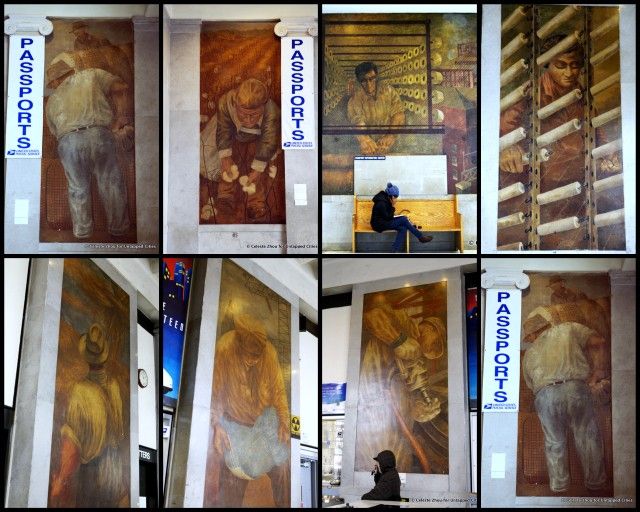
In one of the panes, Whitman points to a blackboard with a verse from his poem. Originally it was supposed to read – “to recast poems, churches, art; (Recast, maybe discard them, end them – Maybe their work is done, who knows).” However, a Fordham University ethics professor argued that the passage was an “insult to all religiously minded men and to Christianity.” As a result, Shahn took a different quote from Whitman’s poem, likely afraid his work might meet the same fate of an earlier mural he worked on – Diego Rivera’s Rockefeller Center mural “Man at Crossroads.”

As the United States Postal Service struggles amid massive debt, it has started selling off its real estate. This includes numerous architecturally and artistically important locations, including the Grand Concourse location. One can only hope that even if the building is sold, its unique art will still be readily available to the public for generations to come.

The Dollar Savings Bank Building at 2516-2530 Grand Concourse was originally constructed between 1932 and 1933 as the Fordham Savings Bank (with later additions) by Adolf L. Muller of Halsey, McCormack & Helmer, the same firm which designed Brooklyn’s Williamsburgh Savings Bank. The building was designed in the Art Deco style and is clad in Texas pink Granite ashlar, red brick, and terra-cotta. The bank’s facade contains epigrams devoted to the importance of saving. Both the bank’s interior and exterior were designated New York City Landmarks.

Source: Library of Congress

The Loew’s Paradise Theater at 2403 Grand Concourse was one of five Wonder Theaters that Lowe’s built in the area. It was designed by John Eberson and opened on September 7, 1929. The Paradise’s auditorium was inspired by a 16th century Italian Baroque garden.
No detail was too small, from the cypress tress, to the murals, to the twinkling stars (they really twinkled) that lined that ceiling. The theater managed to survive through the decades devolving into a triplex with drop ceilings and fake walls, which hid its grandeur. In 2005, the theater was restored and once again serves the Bronx as an important cultural venue.

Poe Cottage, which is currently located in Poe Park
In May 1847, Edgar Allan Poe leased a small cottage in the Fordham section of the Bronx (at the time it was Fordham Village in Westchester County) for $100 a year. While living in the Bronx, Poe published “The Cask of Amontillado” and wrote some of his most well known poems including “The Bells,” “Annabel Lee,” and “Eureka.” One of the reasons Poe moved out to the Bronx was for the sake of his wife, Virginia, who had contracted tuberculosis. Sadly, the Bronx did not provide the miracle that Poe was looking for and in 1847, Virginia died in the cottage.
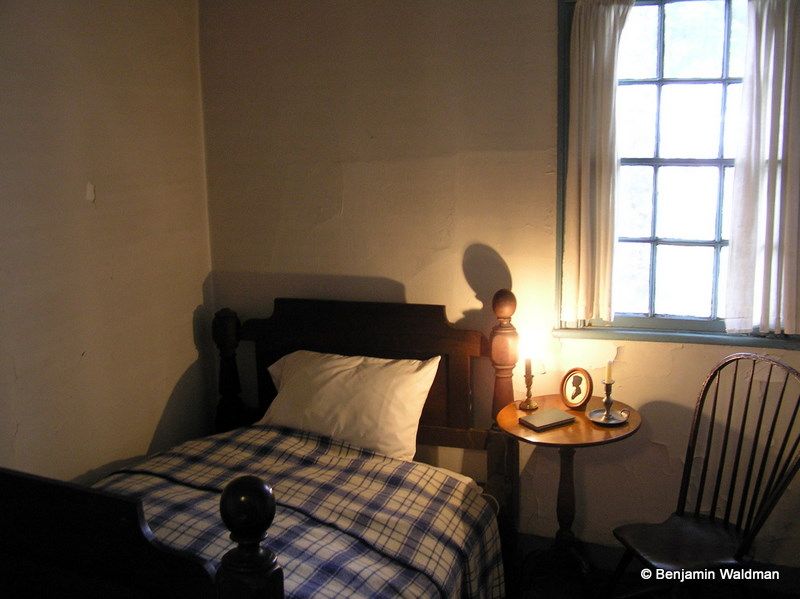
The original bed in which Virginia Poe died
After Poe died, Maria Clemm, Poe’s mother-in-law was left in the house by herself. Unable to afford the rent she sold or gave away many of Poe’s possessions and the furnishings of the house. Between Poe’s death and 1910, the cottage went through a number of different owners, some of whom hoped to save it from destruction. This protection was achieved when the decision was made to move the cottage to a newly created park. The park, named in honor of Poe, was dedicated in November 1913. The cottage suffered much vandalism over the years but its designation as a New York City Landmark in 1966 ensured that it was to remain for future generations. Today, it is one of a number of House Museums located in the Bronx, at 2640 Grand Concourse.

The Fish Building, located at 1150 Grand Concourse, acquired its nickname decades ago as a result of the aquatic murals on its facade. The building was designed by Horace Ginsbern, who designed other Pre-War gems in the Bronx, in the Art Deco style and was constructed in 1937. Even more impressive than its facade, is its lobby. The lobby contains a red, green, and gold terrazzo floor, two murals by Rene and CP Graves, stained glass windows, and even beautifully ornamented walls and elevator doors.

Photo by Lynn Lieberman/AFineLyne
In 1924, Andrew Freedman decided to build a mansion for the wealthy who lost everything – a place where they could live out the remainder of their lives in the manner to which they were accustomed.
By the 1960s, costs had exceeded the endowment and in 1984 the mansion at 1125 Grand Concourse was purchased by the Mid-Bronx Senior Citizens Council who was committed to “creating a fresh vision.” The Andrew Freedman Complex Initiative is a suite of programs filling the needs of their community. These programs are comprised of five distinct tracks, including AFC Small Business Incubator, Green Technology Institute, The Arts & Media Center, Culinary & Hospitality Initiative, which includes an onsite Bed & Breakfast, and on the agenda for the future will be the AFC Apartments, which will eventually have 200 units. We previously covered No Longer Empty’s site-specific art installation in the Andrew Freedman home.

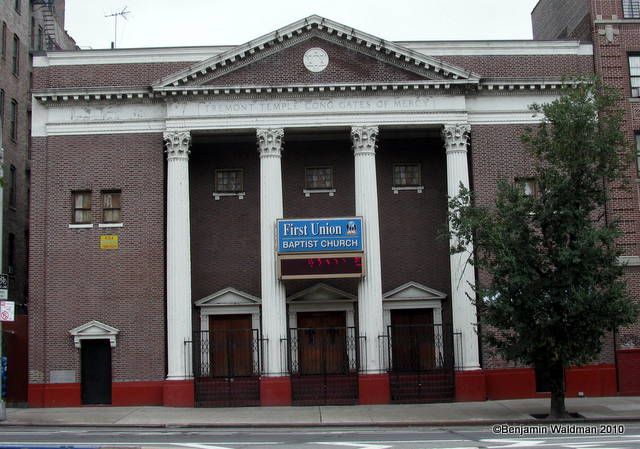
The Grand Concourse was once known as the Boulevard of Dreams. It was the Bronx’s Parisian Boulevard and according to the WPA Guide to New York it was, “the Park Avenue of middle-class Bronx residents, and the lease to an apartment in one of its many large buildings is considered evidence of at least moderate business success.” From the 1920s through the 1960s one of the main groups living on the Concourse were Jews who had left the slums of Manhattan. As a result, there are a number of former synagogues that can still be stopped along Grand Concourse.
The former Tremont Temple Gates of Mercy’s Synagogue (above) is located at 2064 Grand Concourse. It was dedicated in 1910 and completed by 1920. The congregation moved to Westchester in the 1970s and the First Union Baptist Church took over the building.
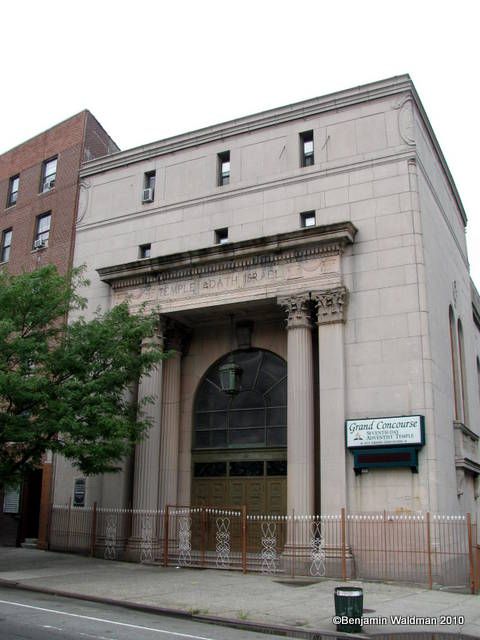
The former Temple Adath Israel located at 1275 Grand Concourse appears out of place with its neoclassical style, which predates the usual Art Deco style along the Grand Concourse. It was constructed in 1927 and it too became a church when its congregation left the area. Richard Tucker served as its Cantor. It is currently home to the Grand Concourse Seventh-day Adventist Temple.
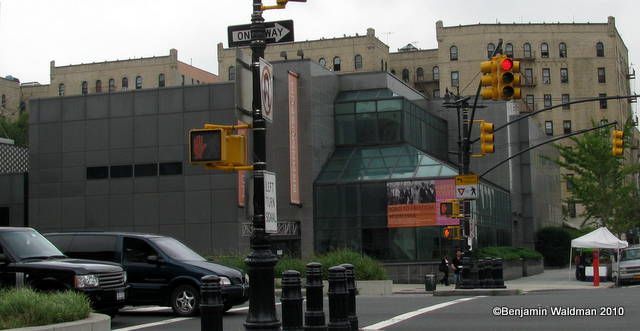
Young Israel of the Concourse began as a small synagogue on Walton Avenue, which after years of raising money was able to move to a new home at 1040 Grand Concourse. Constructed in 1961, the modern building is now home to the Bronx Museum of Arts, which began its life in the Bronx County Courthouse.
Next, check out 10 Pre-War Apartment Gems in the Bronx and learn more about the urban design of the Grand Concourse.
Subscribe to our newsletter